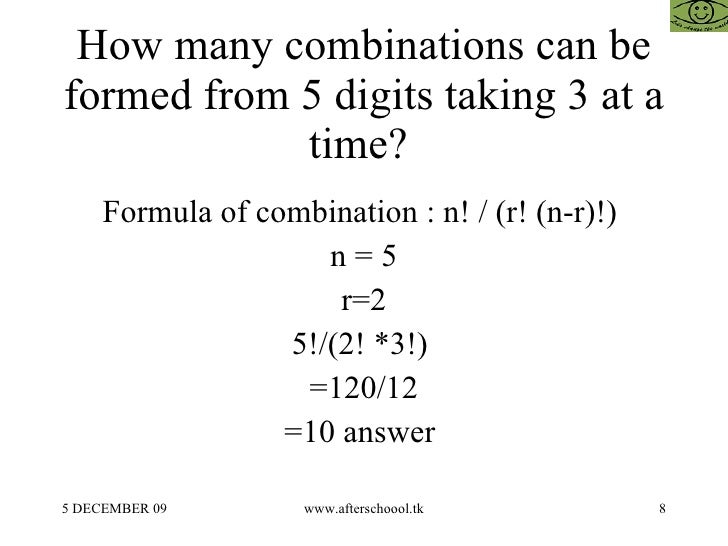
In a Jollibee, you have a menu choice of C1, C2, and C3. How many ways can we select five items so that it is no more than one defective? 36 are first grade, and four are defective. How many points do nine lines intersect in a plane, of which four are parallel, and of the other five, no two are parallel (and if we assume that only two lines pass through each intersection)? intersect and opposite and its combinations):

(214).jpg)
If probabilities of A, B, and A ∩ B are P (A) = 0.62, P (B) = 0.78, and P (A ∩ B) = 0.26, calculate the following probability (of the union. How many orders in which she could gradually read them? Petra borrowed four books from the library at the beginning of the summer holidays. What is the probability that it gets a) all four aces b) at least one ace How many options do we have?įoundation of combinatorics in word problemsĬalculate: (789 choose 786) - (789 choose 3) k is logically greater than n (otherwise, we would get ordinary combinations).Ĭ k ′ ( n ) = ( k n + k − 1 ) = k ! ( n − 1 ) ! ( n + k − 1 ) ! Įxplanation of the formula - the number of combinations with repetition is equal to the number of locations of n − 1 separators on n-1 + k places.Ī typical example is: we go to the store to buy 6 chocolates. Here we select k element groups from n elements, regardless of the order, and the elements can be repeated. Their number is a combination number and is calculated as follows:Ĭ k ( n ) = ( k n ) = k ! ( n − k ) ! n ! Ī typical example of combinations is that we have 15 students and we have to choose three. In mathematics, disordered groups are called sets and subsets. The elements are not repeated, and it does not matter the order of the group's elements. k m ! n ! Ī typical example is to find out how many seven-digit numbers formed from the numbers 2,2,2, 6,6,6,6.Ī combination of a k-th class of n elements is an unordered k-element group formed from a set of n elements. Repeating some (or all in a group) reduces the number of such repeating permutations. n = n k Permutations with repeatĪ repeating permutation is an arranged k-element group of n-elements, with some elements repeating in a group. We calculate their number according to the combinatorial rule of the product: A typical example is the formation of numbers from the numbers 2,3,4,5, and finding their number. 1 = n !Ī typical example is: We have 4 books, and in how many ways can we arrange them side by side on a shelf?Ī variation of the k-th class of n elements is an ordered k-element group formed of a set of n elements, wherein the elements can be repeated and depends on their order. The elements are not repeated and depend on the order of the elements in the group. It is thus any n-element ordered group formed of n-elements. The permutation is a synonymous name for a variation of the nth class of n-elements.

For calculations, it is fully sufficient to use the procedure resulting from the combinatorial rule of product. The notation with the factorial is only clearer, equivalent. N! we call the factorial of the number n, which is the product of the first n natural numbers.

For example, if we have the set n = 5 numbers 1,2,3,4,5 and we have to make third-class variations, their V 3 (5) = 5 * 4 * 3 = 60. The number of variations can be easily calculated using the combinatorial rule of product. The elements are not repeated and depend on the order of the group's elements (therefore arranged). C k ( n ) = ( k n ) = k ! ( n − k ) ! n ! n = 1 0 k = 4 C 4 ( 1 0 ) = ( 4 1 0 ) = 4 ! ( 1 0 − 4 ) ! 1 0 ! = 4 ⋅ 3 ⋅ 2 ⋅ 1 1 0 ⋅ 9 ⋅ 8 ⋅ 7 = 2 1 0 Number of combinations: 210Ī bit of theory - foundation of combinatorics VariationsĪ variation of the k-th class of n elements is an ordered k-element group formed from a set of n elements.


 0 kommentar(er)
0 kommentar(er)
